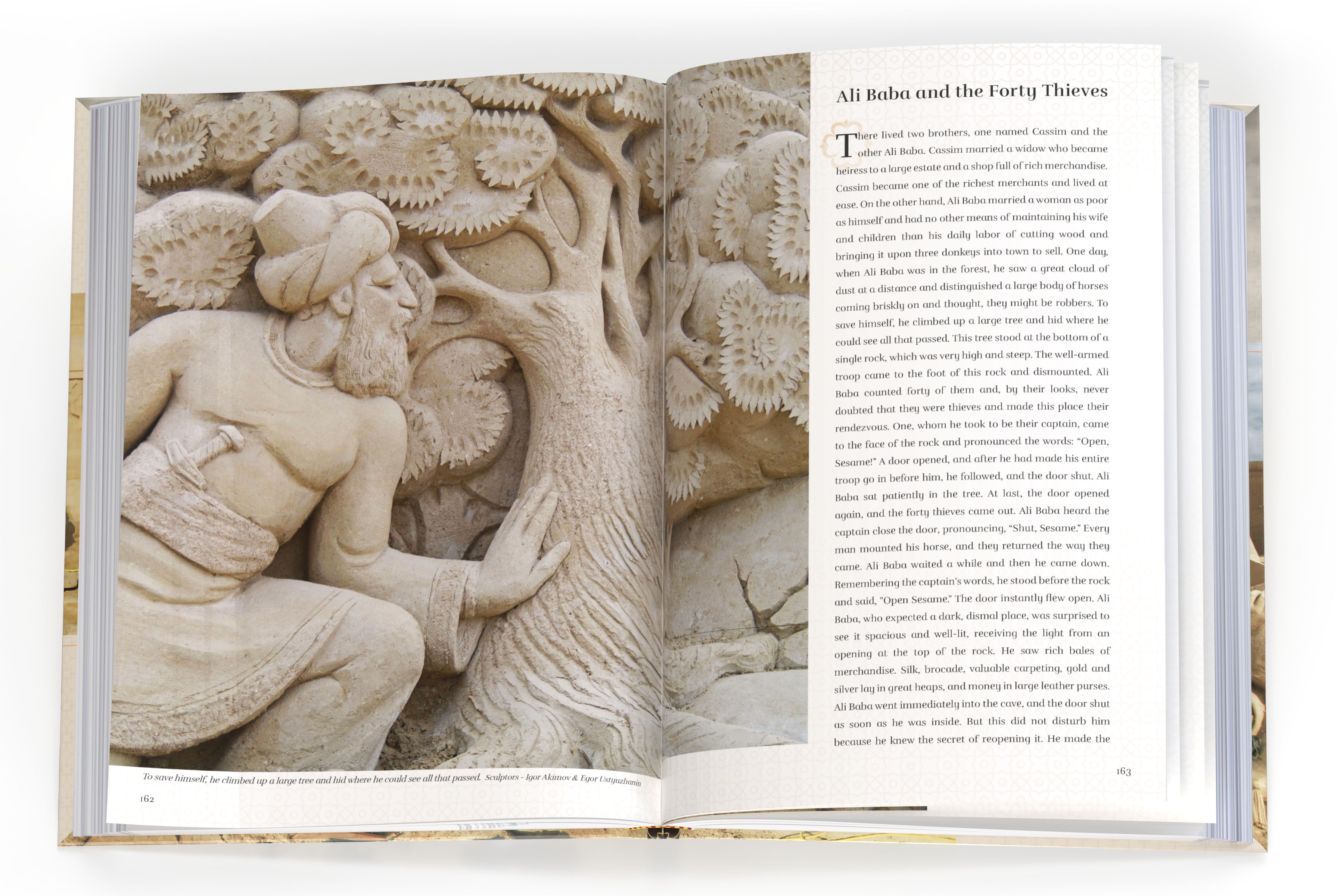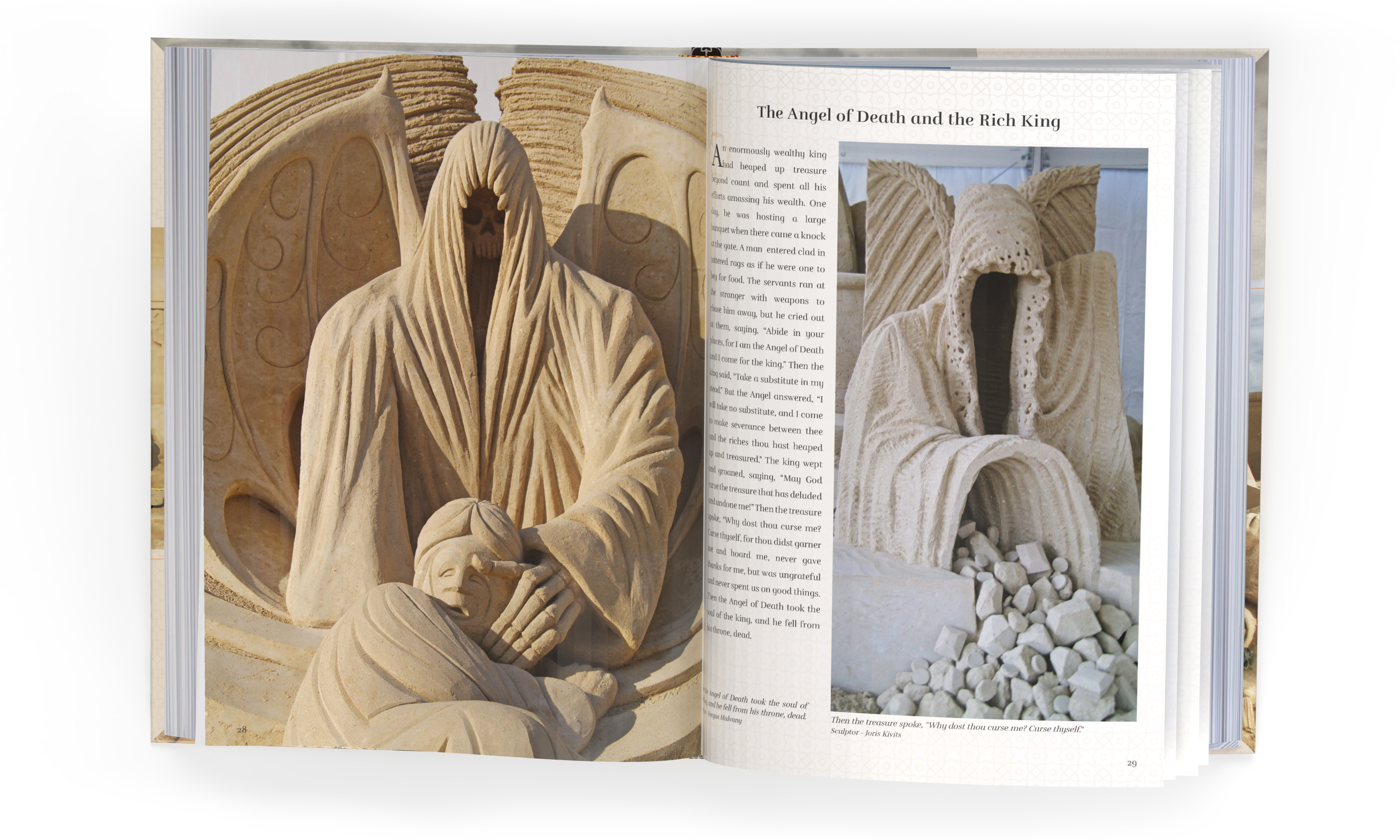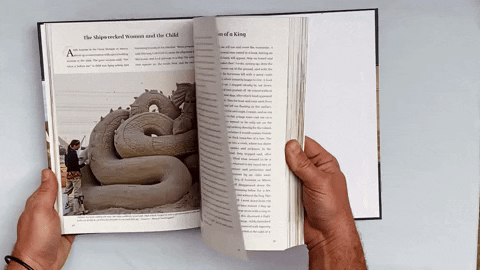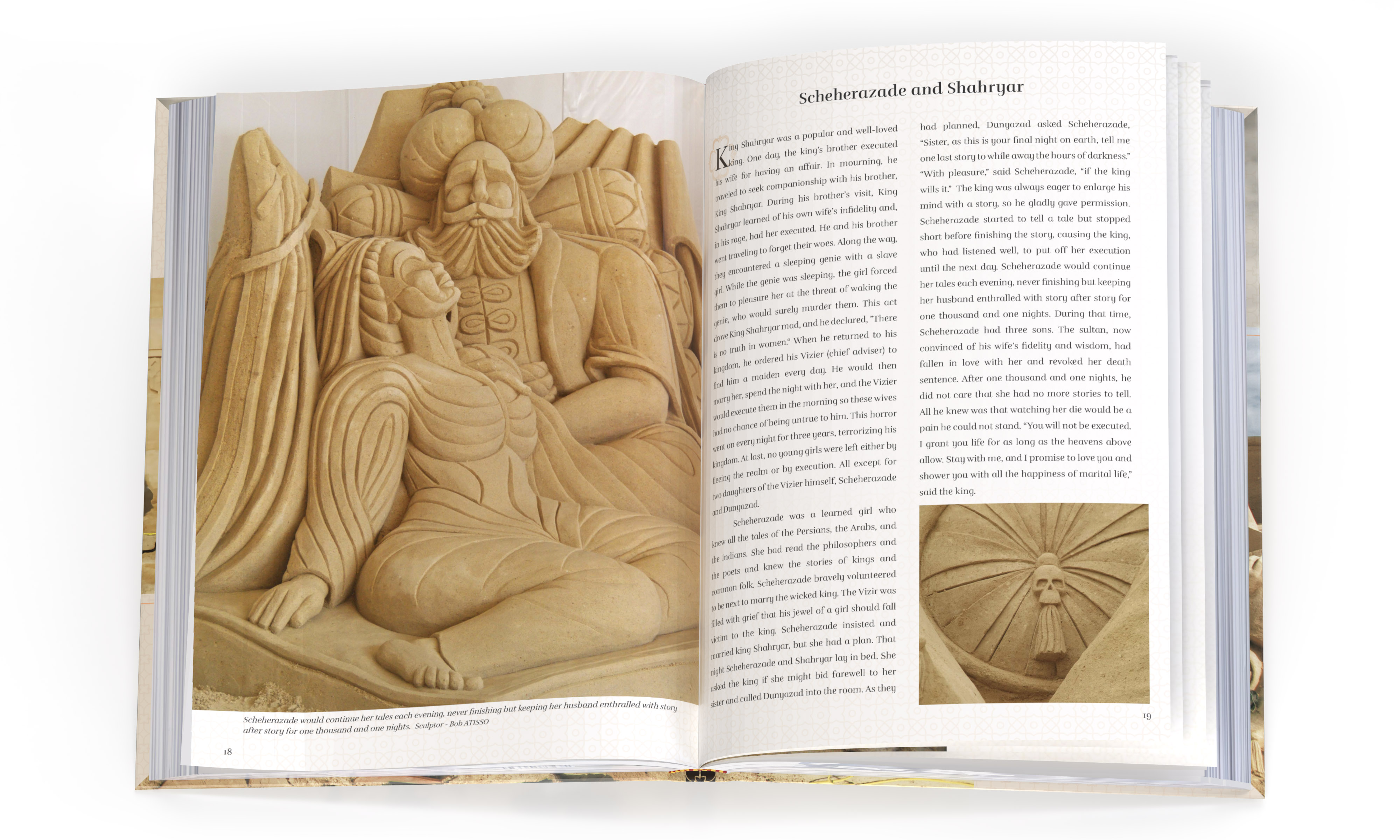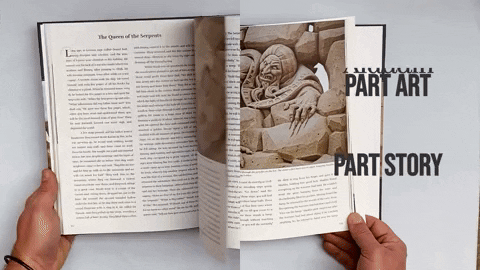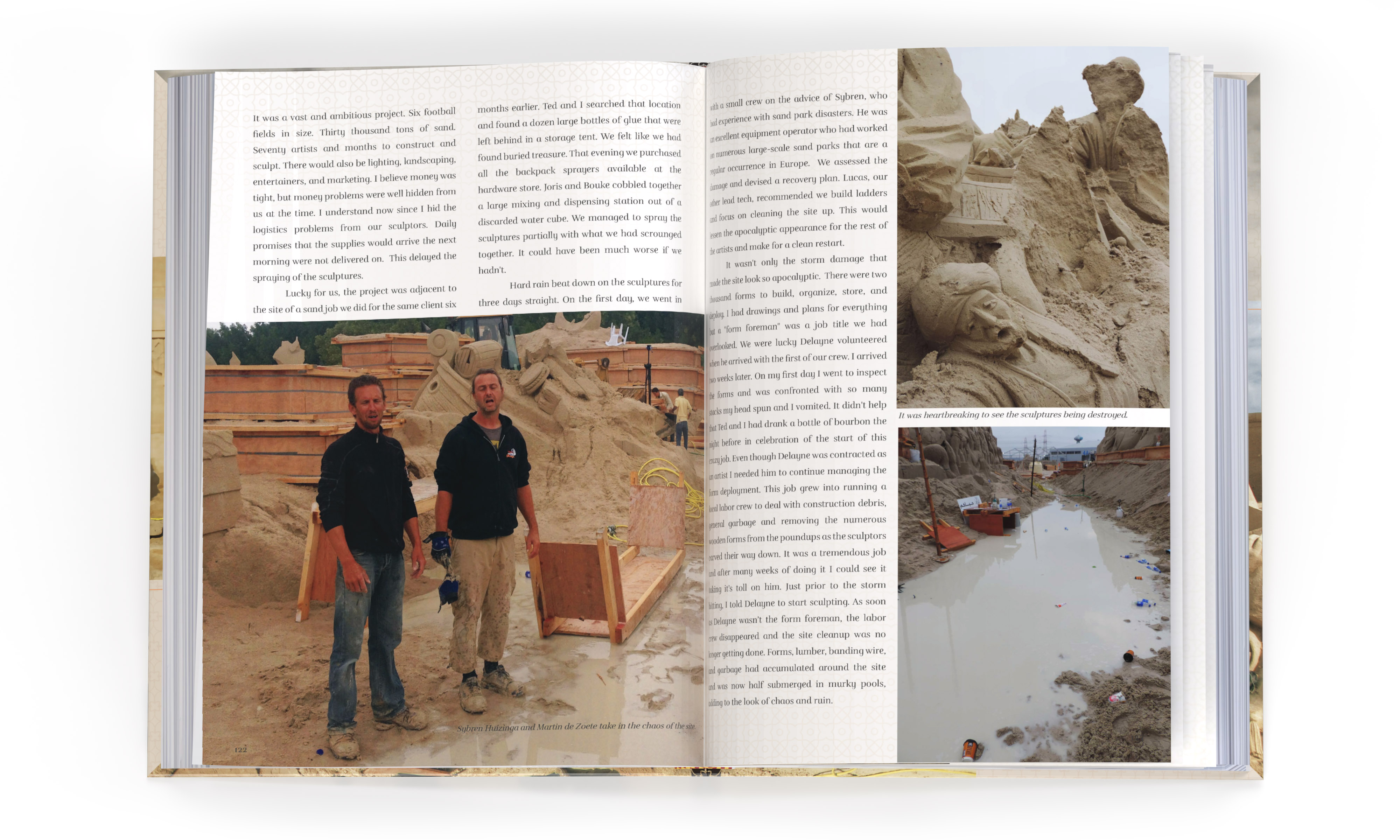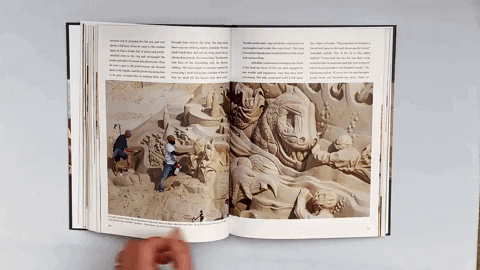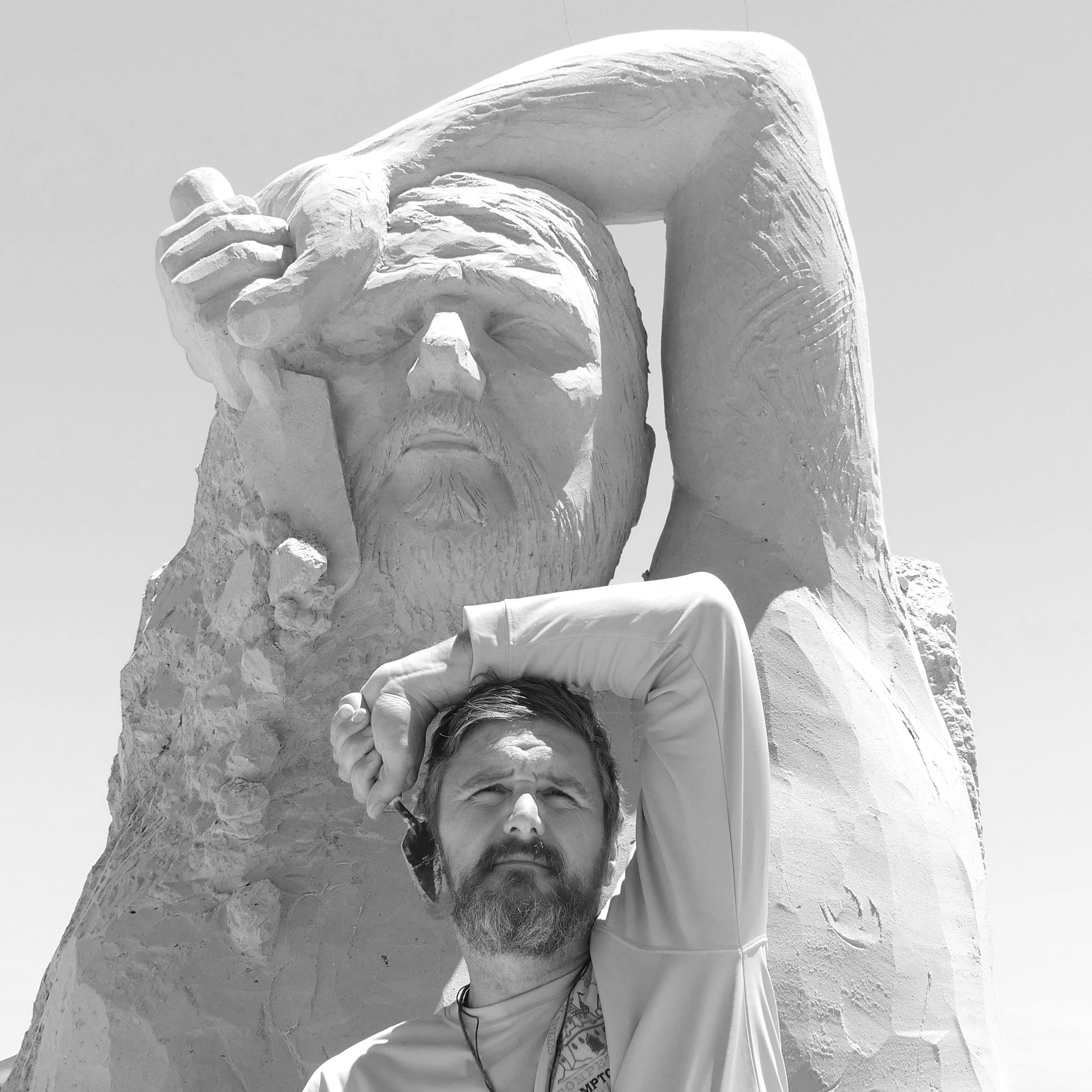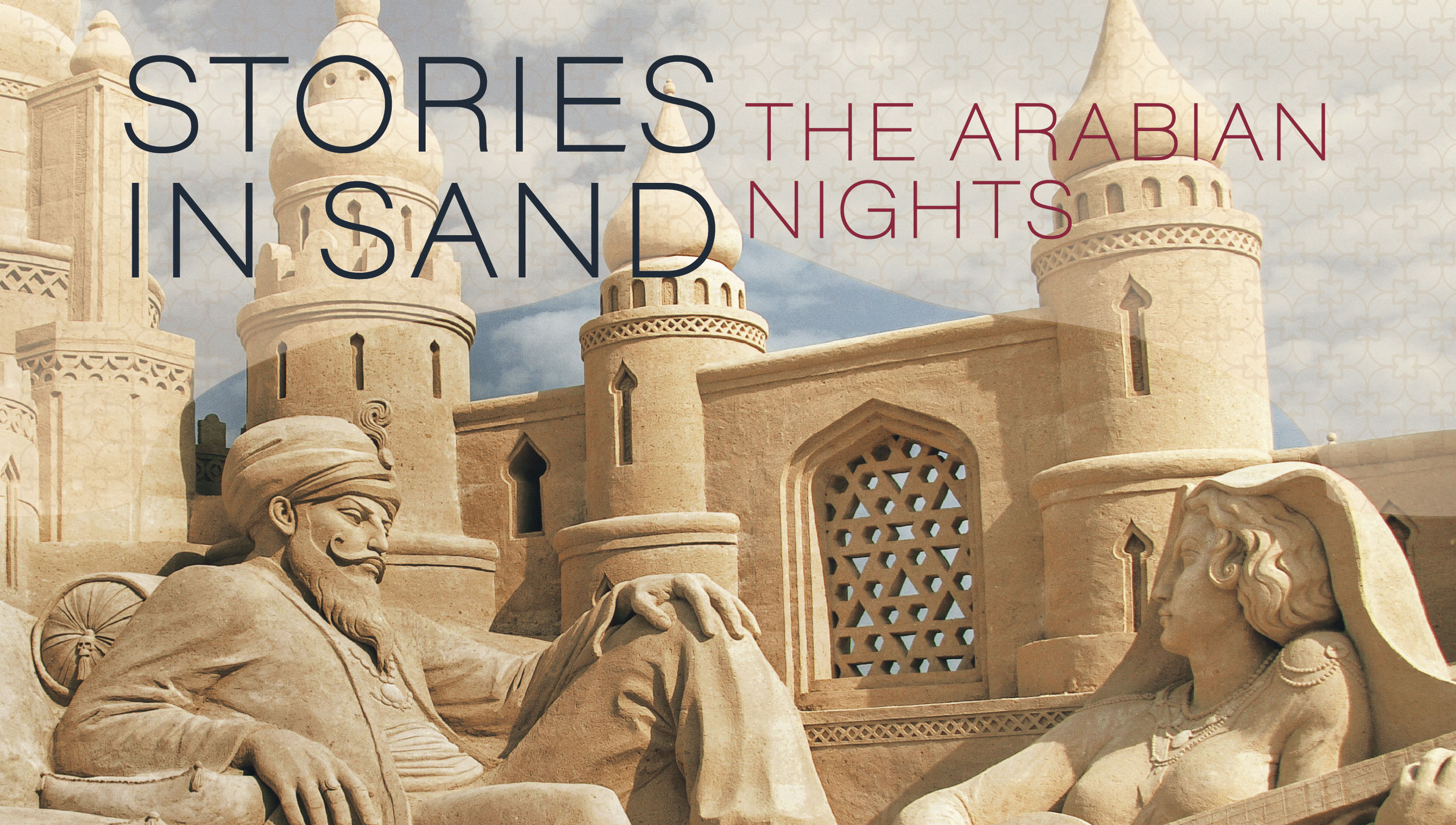Interview By Mathilde Dubois.
Today we are sitting with Damon Langlois, a sand sculptor and the author of a new book named Stories in sand.
Tell me more about you?
I’m Damon Langlois and I’m a sand sculptor, product designer that comes from Victoria, British Columbia, Canada. I have been both a designer and sculptor for my entire creative career of thirty years. Now I can add author to that list with my new book “Stories In Sand”.
If we had to summarize this project in a few words, what would you say?
A few words will be difficult. I would say it’s got three levels to it:
- The first level it’s a gallery of sand art by the most amazing sand sculptors in the world.
- And the next level is a good entry point into the stories of the Arabian nights. I rewrote these stories, made them clearer, shorter and then illustrated them with these sand sculptures that I photographed.
- The third level is documenting the largest sand sculpture park that was ever made. created in Kuwait about 10 years ago, the park was about six football fields in size. We had 72 artists for months carving sculptures that represented the tales from the Arabian nights and my photographs of those sculptures are what make the backbone of this book.
Why did you write this book?
Because I had to!
I was the creative director in charge of the artistic visioning of the largest sand sculpture park ever created called the Remal festival in Kuwait. It’s theme was the Arabian Nights and I had the idea to have a book like this at the event. Like a program guide, adding the background to the sculptures the viewer would experience in the park. With this the visitor could be looking at the sculptures and know what story from the Arabian Nights they were depicting. Of course, someone reading it all while visiting the event was not going to happen, but they could take this book back with them and be able to really absorb these stories over time. This event program never materialized. At the time I had written these versions of the stories, it was mostly to inform the artist about their sculpture assignments. I had this written material for years, hidden away. As the ten-year anniversary of the event approached, I decided that I was going to actually turn this book into reality, now illustrated with my photographs from the sculpting of this park. I started about a year ago and once I had some sample pages and I was compelled to finish it since this format really conveyed the cinematic nature of this production. It was a better format to take in what we created. We put so much creative energy into this park. It was a million-dollar production with seventy-two of the best artists in the world. When it was sculptures visited live the public only enjoys them for a brief period. With this book, you can look at these sculptures, look at the photos, read some stories and come back to them time and time again. This book did this work of art the presentation it deserved and could let more people appreciate it.
Tell me more about the sand sculpture festival you organized.
We didn’t organize it, but the Sand Sculpture Company was contracted to do the sand sculpture aspect of the Remal Festival, Sand Sculpture Park in Kuwait. As the creative director, I went into a deep dive with the stories from the Arabian Nights because I wanted to understand the theme in a deeper way, and I ended up rewriting the stories I chose so I could use them to inform the artists were going to do the actual sculptures of the stories. I wanted to give them a story summary so that they could put their heart and souls into their sculpture and not just execute a design. So, this project stems from my work of doing the design and directing of the Remal Sand Sculpture Park. Then, during the actual sculpting of the park, I took photographs of all the work. My intention then was to document what was my aspect of the project, the design and directing of it. This book stems from both those photographs, but also those rewritten stories in their shorter form.
Over the years these stories and this massive collection of photographs sat in my file folder and I would think to myself, “I should turn this into a book.” and eventually that’s what I did and here we are.
How much time did it take to create this sculpture project?
It’s a little bit gray but the planning and design stage was in the neighborhood of four months It started when Ted Siebert gave me a call that he had a proposal for a mega project from Yousef (the main organizer). We had done a sand sculpture project for him about six months prior to this proposal for a event he had produced called Proud To Be Kuwaiti. He contacted Ted with an idea for a much larger sculpture park and at that time he was proposing something in the scale of 20,000 tons which is quite big. Ted called me up and asked f I would you be interested in working with him on this and I said it’s sounds crazy. In the meantime, Yousef bumped it up to 30,000 tons. It was quite ambitious and at the time we were thinking maybe we wouldn’t want anything to do this. It was just too much to believe it was possible. Eventually Ted’s bravado led us to agree to do this. We took it on and from that moment it was research time for me. I started collecting books on the Arabian Nights and reading all the stories. I started doing layouts and working with Yousef to decide what stories we were going to represent and selling the concept in general. We went through many versions of the park layout. I sketched many different sculptures to visualize the scenes and created the park in full as a miniature illustration that is in the book. I had also run a design studio called Codetta product design and my number two, Bryn, was also helping with the project. He modeled everything in a program called Sketch-Up so we could do walk-throughs. When the actual sculpting began, we first have a process called the pound up. That’s where you take the sand and water, and you compact it into forms and build the piles that we carve. That whole process began a little bit before the sculpting which took seventy-two artists and technical experts over three months to create.
What can we find inside this book?
Hundreds of my photographs of these amazing sand sculptures paired with shortened, more concise versions of the stories that they represent from the Arabian Nights. As I like to say, Part art, part storybook. There is also some of my design work that’s in the appendix. I have highlights of my concept and layout sketches and technical design included. You can get a window into what it takes to design a sand sculpture park like this. There’s also our story in there, the story of us making the sculpture park that is represented in a couple ways subtly through the photographs as many of the photographs show the sculptors working on their pieces, and this is interesting on two fronts.
One, it shows the scale of these sculptures. Two, also gives you a feeling that this was made by a group of artists, and the camaraderie, and grit in overcoming the challenges that we had to face to make this park a reality shine through. I have added short stories of our adventures into the mix of Stories In Sand. For instance, one of the stories is called “The Storm.” Where I tell our tale of this sculpture park being created at a massive scale and halfway through being impacted by a three-day rainstorm that decimated the park. You are going to find an amazing art book on sand sculpture with these short versions of the Arabian Nights entertainments, but also our story making this park.
What makes this book unique?
And a lot what I just said. Fist of all, the art of sand sculpting is quite unique itself. There is not really a lot of art like this, that the public really engages with. Not a lot of people go to art galleries, but sand sculpture events are very popular. That is because of the WOW factor, it’s like magic for people. Everybody has some experience with doing something on the beach, making a Sandcastle, making piles, digging holes. A sand sculptor makes that sand into works of art that defy gravity, that just really does something for people. The art itself is incredibly unique and then on top of that this event was insanely huge, it’s hard to describe the volume and scale of these sculptures. I have hundreds of photographs of these sculptures that both illustrate the Arabian nights but also show the sculptors working which gives a hint to the immense achievement of this undertaking. The other level that makes it unique is as an addition of the Arabian Nights, nothing else out there is like this. The stories are clearer and more concise and uniquely illustrated with sand sculpture. In general, a storybook that is illustrated by sand sculptures is unique. There’s nothing else like this out there in the book or graphic novel realms.
Why should we read your book?
I think it’s important for people to read the original stories of the Arabian nights. It’s not only entertaining but educational. It was a revelation for me that the stories in the Arabian Nights capture a lot of the structures that you see in modern novels and modern movies. Mechanisms like the flashback, the interview, stories within stories and even zombies are in there. It’s interesting reading these ancient tales having super strong, female protagonists that one might think is a more modern tendency. The bottom line is the stories are just super interesting to read. It’s almost like a hidden knowledge. It just blew me away that all this material can be drawn from and probably is used by a lot of creative people to this day. It certainly was for Disney. It’s there for everyone especially because these works are in the public domain. The writing is so old that anybody can take from it. The next level is the sand art it presents. If you’re a fan of sand sculpture, or art in general, these are really some of the best sand sculptures and sand sculptors represented in the world. It is art history in the making. As an art book and as a gallery of sand sculpture it’s unique. Combining that with the stories from the Arabian Nights, it makes it a book like no other.
Is it more of a photo book or a storybook?
It really is truly both. Also, because the photos themselves of the sculptures are telling the story. They’re not just sand sculptures individually themselves, the sculptures are representing scenes from the stories. They were intended to be like panels of a graphic novel. The sculptures were representing some moment in the story, or some thematic element of the story. Like a graphic novel, the photos and the stories are not separate, they play off each other. It is both a photo book of the sand sculpture and a storybook on the Arabian Nights.
How much time does it take to make one of these sculptures?
Well for this event, a lot of the pieces were done by teams and so it’s hard to really pinpoint how long a single sculpture would take. The advantage of sculpting sand is the speed that you can create something is very quick. The material is removed quite easily. Of course, you have also the disadvantage of gravity and susceptibility to weather events. This is why we could make this huge, sculpted theme park in such a short period of time.
An individual sculpt sculpture, like some of the solo sculptures that were there in the gallery would take 4 or 5 days for a single artist to do a sculpture 8 feet tall. Sculptures like the palace, that was 52 feet tall. With a dozen people working on it took multiple weeks to create. That is still incredibly fast.
Why did you choose the theme of The Arabian Nights?
As soon as we were contracted with this huge project, it made sense to do something that had a unifying theme. This was going to stay up for a couple months and be a happening place that people could come back to and absorb over time. We wanted more than a simple walk through with this park. We wanted to do a cultural event. This was in Kuwait and in the Arabian world, so the Arabian Nights seemed natural. As soon as I started to look into the different translations and do some deep research, it was a no-brainer. These stories had so much to them. We are all familiar with Sinbad and Alibaba. The Disney versions of the stories is what would lead us here but as soon as I start reading the original stories, the depth to them was captivating to me. I discovered that these stories are the foundation of so many modern works of fiction. All these genres are already in there. Murder mysteries, romantic comedies, everything. So, as I was reading the stories, I realized we had to do justice to this topic. We didn’t want to just touch on the surface level only. We wanted to reveal the true versions of both the familiar stories and unveil so many unheard-of tales show cultural respect with the art.
What is your favorite sculpture? And your favorite story?
It’s difficult to answer that. I think one of my favorite stories is Codadad because it’s such an epic fantasy story of betrayal, forgiveness and triumphant victory. It also has these amazing sculptures. But I think my favorite sculpture itself is the palace. Because the palace has so much to it. The representation of Shahryar and Scheherazade in the moment of Scheherazade telling Shahryar the stories. Because the frame story of the Arabian nights is Shahryar as he has lost his mind. He is the king and he’s taking his revenge on his people for the events that happened to him. You will have to read the book to find out more on that back story. He is killing the women, the virgins of his village, marrying them and then murdering them. Scheherazade stops that process by essentially telling him these captivating stories every night and keeping him in suspense wanting to hear more. He spares her because he wants to hear the next story and hear the next story. She tells him 1001 stories and by the last one he declares his love for her and it ends his madness. That is beautifully represented on the top one of the most amazing Sandcastles ever made. When you’re at the event you could walk up and stand on it and in it. From this vantage point you could look over out over the entire park and you can see all these different sculpted vignettes. It also provided the backdrop to all these other sculptures that were amazing.
Who can read this book?
Some of the stories are maybe a little edgy for children. If it was a movie, I’d say it’s has a PG 13 rating. It’s almost like the original fairy tales and fables. When you read those original versions, there are some harsh things that can happen in them. So some stories might not be the best for your six-year-old at bedtime. I think it’s a book for anybody who is a fan of fiction, especial the fantasy genre. There is a historical reference that I am positive many authors have taken inspiration from. There are morals and themes in them that have unique and familiar perspectives. If you have any interest in sand sculpting, you are then this book is a must have.
Why did you create a Kickstarter campaign?
Now that I have made the book and I have sold some artist proofs through my Etsy store, I realize that it needs to get out there in a bigger way. With the Kickstarter campaign, it makes into an event, and it makes it into something that has some excitement around it. It can also be a vehicle to get noticed in the grand open expanse of the Internet. I’m counting on a Kickstarter campaign to do that for me. It will also help fund what’s called an offset print run. My artist proofs were printed on what’s called a digital press. An offset press is a more traditional printing process where they make plates and it produces a better quality product. That means I have minimum order quantities so the expense of doing an offset run is just too much for me to do on my own. Kickstarter is a platform that can help me to fund this through pre-sales. The campaign enables people to pre-order the book to fund printing it at a larger volume and then it’ll also help me to set up distribution. Also, when the Kickstart is successful, I believe that will provide credibility for a larger publisher to pick up the book.
When will the Kickstarter campaign start?
The fundraising will run from February 6 at 7 AM until March 7 2024.
How much money do you want to raise for this campaign? What will it be used for?
It will probably be a last-minute decision but for now, I’m setting to goal at C$14,000 ($10,337 in US dollars). This is slightly lower than my total expected cost and I hope for more but Kickstarter is all or nothing. This is at a level where I can fill in the rest of the funds myself if need be. My minimum order quantity is 250 books but hopefully I can make 500 as it is not a big difference in cost compared to 250 but I will need the pre-orders to do that. I am aiming for the absolute amount of money that allow me make this book a reality.
Why is it important to get involved in your project now?=
With Kickstarter campaigns early activity influences the algorithm that decides what to promote within Kickstarter. Backing the project earlier helps pump up the exposure basically. With most platforms on the internet there’s an algorithm that decides what it’s going to put in front of people. Campaigns that have a lot of initial interest end up getting promoted more within the Kickstarter site which can lead to more exposure in general. Within my project there’ll be more rewards than just pre-ordering the book. For instance, there will be an early bird book pre-order. The book itself will be C$99 and I’ll have an first eighty books C$69. That discount is to motivate people to get on there and back it early. There will also be the eBook for $20 and a few other rewards. There is even a dollar that you can donate to the project. That lets you follow it and get updates, but even just donating a dollar helps the algorithm push the project.
How can we support this nice project?
The fundamental reward for backing the project will be pre-ordering the book. If you go to Kickstarter and look up “Stories In Sand, the Arabian Nights” my campaign will be there. As soon as February 6 comes, you’ll be able to back the project. In the Kickstarter terminology that means choosing “rewards” for this project that will primarily be pre-ordering the book. I also have a reward where I will sculpt your portrait and send a high-quality photograph of it. I have two of those available for $1000.You can support the project by going to the Kickstarter campaign and choosing any of these rewards and, like I said earlier, even a dollar to just follow the campaign helps promote it.
If I preorder the book, when I will receive it ?
You should receive it in April. The campaign is 30 days. Within Kickstarter it’s all or nothing. So after 30 days the funds will be released and then I will be able to start the process of ordering the print run. Stories In Sand is completed so I don’t have to do any production on the book itself. I can immediately release the files to the printer and then that process starts. That’s about three weeks. Then there is shipping. I’ll be setting up the distribution ordering system with a fulfillment company, so I expect shipping to go quickly. I would estimate people will receive the book sometime in April of this year.
What would be the key figures to highlight?
Ted Siebert from the Sand Sculpture Company. I would not be involved in this project if it wasn’t for him. We worked together for decades, and we partnered a lot in these big projects. I tend to the front-end design and engineering on our projects like when we worked together on the tallest Sandcastle in the world in 2015. He likes to carve and let me do the overall direction. This whole project wouldn’t have happened without him. Also, Yousef Aldaour. He was the lifeblood of the Remal Festival where these sculptures originated. He was the starting vision of that event. Then all the artists themselves. There are too many to name here, but they really did shine on this project. They are all credited in the book and some of their best work they have ever done is captured with these pages. This is another reason for making this book is to give back to them and to the community of sand sculpting that has given me so much. To showcase this art in its highest form. This many sculptors, working together to make something at such a scale is truly unique. A lot of people just don’t get a chance to witness this. This book really pays tribute to the sand artists that worked on it
Where can we follow you? Facebook, Linkedin, Twitter, Instagram, etc.
I’m on Facebook, Instagram and Linked In. I’m easy to find as Damon Langlois. Also Dasmo publications on Facebook and Instagram too. That’s where you can find more information about Stories In Sand. I’ve got highlights from the book that you can preview on the website http://www.storiesinsand.com That’s also where you can get links to follow me on social media and find links to the Kickstarter campaign.
Finally, do you have an anecdote to tell us?
I’ve got a few of them in the book that I don’t really want to say here because they are too long. I have a a short one though. Halfway through this project a three day storm almost the destroyed the entire sculpture park. For a sand sculptor, this is a risk we always face when we’re making a sculpture because gravity, weather, all those things are always looming as potentially dangerous for what we do. It’s only sand after all, so it’s not uncommon to just have your sculpture collapse. At sand sculpting competitions you’ll see collapses often. Even if you have a total collapse with an hour to go a sand sculptor will make something from it. This was like that but at on a huge scale. We were halfway through, it was just so amazing. The whole thing was just coming to life and then we had this storm. It was so intense. They called it a storm once every 50 year storm. It was so crazy, people were jet skiing in the flooded streets of Kuwait, and it just decimated the work.
After the storm had subsided, we contemplating what to do next. Sybren, one of our tech, leads had experience with sand disasters because of making these style sand sculpture parks over in Europe over the years. He gave advice to not bring everybody to the sculpture site right away. To just bring a skeleton crew and get in assess the damage and prepare for the entire crew to arrive to fix everything. We went to the site, and it was apocalyptic. It was flooded, sculptures were crumbling before our eyes, and it was totally demoralizing. The small crew and I were taking it all with stoic resolve except for one person. He was just grinning from ear to ear. This was Wael, the filmmaker who was contracted to film the making of the festival. At the time I was a little shocked since it was a horrible feeling to be in the middle of this disaster. Latter I understood why he was grinning. This was the beginning of a great story arc and he was a story teller. Looking back at it now, that was an important part of it for all involved. The event wouldn’t have the same emotional impact for myself if we had pulled it off seamlessly. This epic nature of the creation of this park is part of the inspiration to create this book. We came back from this point and rebuilt it and it turned out equally amazing. If you hadn’t seen it before, you wouldn’t even know that it had been decimated. Well, people did know because it was all over social media. It is always exciting when a sand sculpture collapses. When a sand sculptor has a collapses, we take some solace that it is also contributing to the show. It is an unbelievable feat for the sculptors to face that adversity and disappointment at this scale and come together to pull off something equally great. During the making of this book and getting into the mindset of the storytelling and narrative, I would often think about Wael smiling in the midst of the ruin.
In the Appendix of Stories In Sand, I include highlights from my design sketches. Pictured here is the sand palace on the left and the overall layout on the right. I think this drawing was version seventy. The palace was a full walk-over, and the walk-under sculpture. We used shipping containers for the tunnel. It did collapse in a little as the sand was filled in around it  Paving stones were placed throughout the park which really polished things off nicely.
Paving stones were placed throughout the park which really polished things off nicely.


